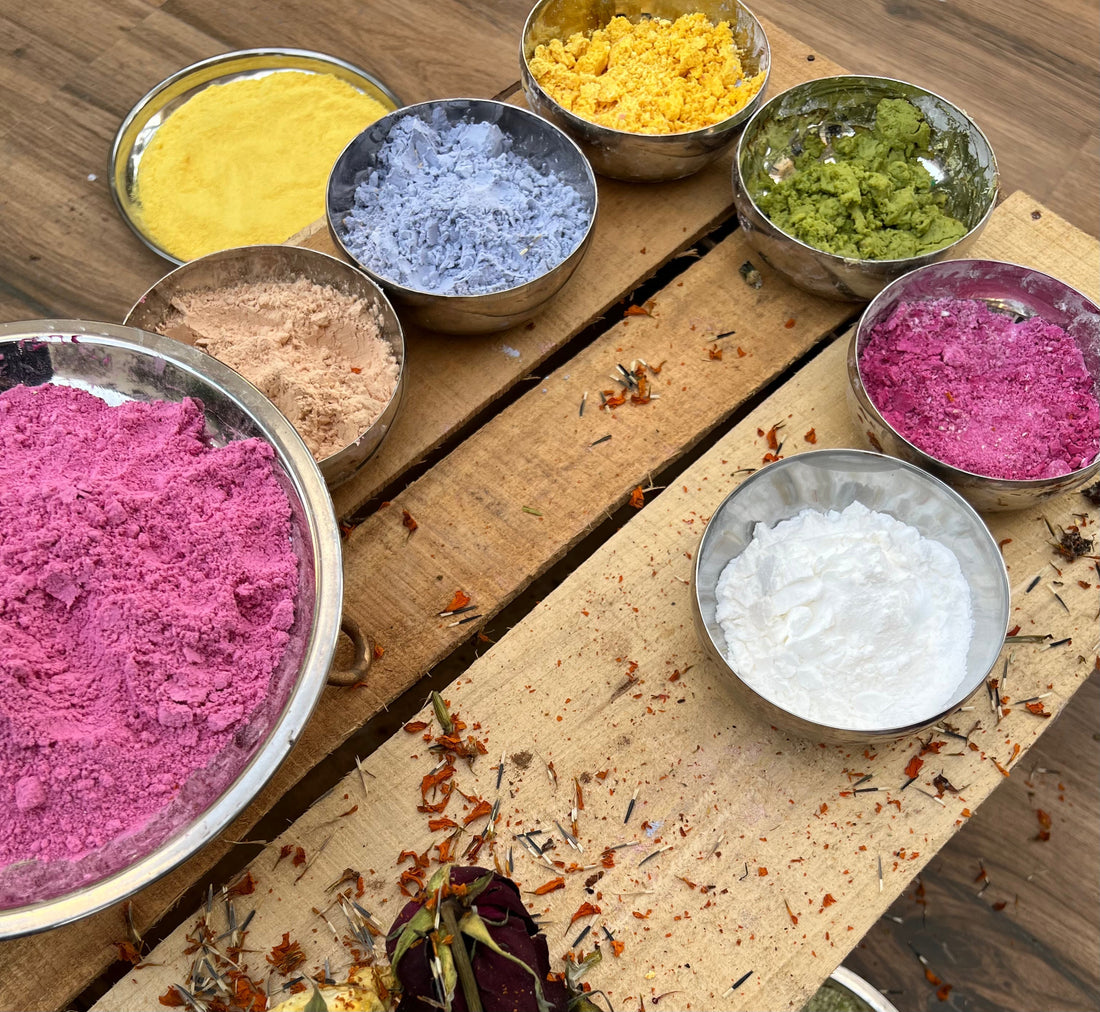
How to Make Organic and Natural Holi Colors at Home
Holi is a festival of colors, joy, and togetherness, but the synthetic colors commonly used today contain harmful chemicals that can cause skin allergies, respiratory issues, and environmental pollution. The best way to enjoy Holi without these risks is by using organic, natural colors made from readily available ingredients. These colors are safe for your skin, hair, and the environment.
In this guide, we'll explore how to make different natural Holi colors at home using herbs, flowers, and kitchen ingredients.
1. How to Make Red Holi Color
Red is one of the most popular colors of Holi, symbolizing love, energy, and prosperity. You can make this at home using roses, hibiscus, or red sandalwood.
Ingredients:
- Rose petals or hibiscus flowers (dried and crushed)
- Red sandalwood powder (optional, for a deeper shade)
- Cornstarch or rice flour
Method:
- Collect fresh rose petals or hibiscus flowers. Dry them in the sun for 2-3 days until they become crisp.
- Once dried, grind them into a fine powder using a mixer or mortar and pestle.
- Mix the flower powder with cornstarch or rice flour to give a soft, smooth texture.
- If you want a richer red, add a small amount of red sandalwood powder.
- Store in an airtight container.
Alternative Method (Wet Color):
- Soak hibiscus flowers or rose petals in water overnight.
- Blend and strain the mixture to get a deep red liquid.
2. How to Make Yellow Holi Color
Yellow is associated with happiness, positivity, and energy. The best natural sources of yellow color are turmeric and marigold flowers.
Ingredients:
- Turmeric powder (haldi)
- Cornstarch or gram flour (besan)
Method:
- Take 2-3 tablespoons of turmeric powder and mix it with cornstarch or gram flour in equal quantities.
- Sift the mixture well to remove lumps and get a fine powder.
- Store in a dry container.
Alternative Method (Wet Color):
- Boil water and add turmeric powder to it.
- Let it cool and use it as a yellow Holi water color.
Note: Turmeric can stain clothes and skin temporarily, but it is completely safe and beneficial for the skin.
3. How to Make Pink Holi Color
Pink is a gentle yet vibrant color representing love and festivity. Beetroot is the best natural source for making a pink Holi color.
Ingredients:
- Beetroot
- Cornstarch
Method:
- Take 1-2 beetroots, peel, and chop them into small pieces.
- Blend the beetroot with a little water to extract juice.
- Strain the juice and mix it with cornstarch for a powdered color.
- Let the mixture dry in the sun for a day. Once dried, blend and sift for a fine texture.
Alternative Method (Wet Color):
- Simply mix beetroot juice with water for a rich pink Holi color.
4. How to Make Green Holi Color
Green represents nature and renewal. The best way to create green Holi color is by using neem, henna, or spinach.
Ingredients:
- Neem leaves / Spinach leaves
- Cornstarch or rice flour
Method:
- Take fresh neem or spinach leaves and dry them in the shade (avoid direct sunlight to retain color).
- Once completely dried, grind them into a fine powder.
- Mix with cornstarch or rice flour for a soft texture.
- Store in an airtight container.
Alternative Method (Wet Color):
- Blend fresh spinach leaves with water, strain, and use it as green color water.
Note: Henna powder can also be used, but it might leave temporary stains on skin and clothes.
5. How to Make Purple Holi Color
Purple is a rare and beautiful color that can be made using jamun (black plum) or purple cabbage.
Ingredients:
- Jamun (black plum) or purple cabbage
- Cornstarch
Method:
- Extract jamun juice or boil chopped purple cabbage in water.
- Strain the liquid and mix with cornstarch.
- Let the mixture dry in the sun, then grind and sift for a smooth powder.
Alternative Method (Wet Color):
- Use jamun juice or boiled purple cabbage water as a liquid color.
6. How to Make Blue Holi Color
Blue is a peaceful color that can be made using blue hibiscus flowers or indigo leaves.
Ingredients:
- Dried blue hibiscus or indigo leaves
- Cornstarch
Method:
- Dry blue hibiscus flowers or indigo leaves completely.
- Grind them into a fine powder.
- Mix with cornstarch for a softer feel.
Alternative Method (Wet Color):
- Boil blue hibiscus flowers in water and let it cool.
Who Should Use These Natural Holi Colors?
These colors are perfect for:
✅ People with sensitive skin or allergies
✅ Children and elderly who are more prone to skin reactions
✅ People who prefer eco-friendly, chemical-free alternatives
✅ Anyone who wants to celebrate Holi in a safe and sustainable way
How to Store These Colors?
- Keep them in airtight containers to prevent moisture.
- Store in a cool, dry place.
- For liquid colors, refrigerate them and use within 1-2 days.
Final Thoughts
Making organic Holi colors at home is an easy and fun way to bring back the traditional spirit of Holi while protecting your skin and the environment. With just a few simple ingredients, you can create beautiful, vibrant colors without any harmful chemicals.
This Holi, go natural, go eco-friendly, and celebrate safely!
